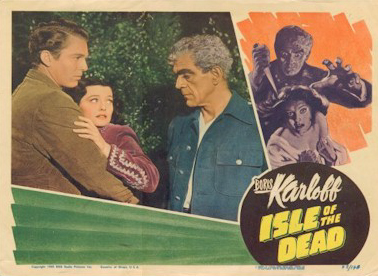![]()
|
"Isle
Of The Dead" 1945 An excellent film which was originally dismissed by both critics and fans. Recently some critics have begun to take notice of the subtle way the film makes some very poweful statements. Part of the trouble may have been the way the film was sold to audiences. Looking at the original artwork on this page one might think this film was a typical monster movie. This is not the case. Infact, like all the other films discussed on this site there are no monsters in this film! Additionally Karloff does not depict a killer as the artwork suggests. "Isle
Of The Dead" takes place in 1912, near the end of the Balkan
Wars. Karloff plays the role of a Greek general who travels to a small
island to visit the wife's grave. Once there he discovers the island
is infected with the plague. The
film resembles a stage play with all but the first few minutes occuring
in the only house on the island. On the surface the horror comes from
the small group of people in the home slowly die from the plague,
one after another. But there is a much deeper message to the film. The eldest woman on the island believes that the youngest woman is evil and has brought the plague upon them. Her belief is founded upon old Greek superstition. General Pherides is to rational to believe in religious superstition. But as the intense psychological stress of the situation wears upon him he begins to fall victim to the religious superstitions taught to him as a child. At the climax of the film the young woman is mistaken buried alive in a mausoleum. Once she escapes from her casket Gen. Pherides believes that he was correct to begin putting credence in the religious superstitions. The stress has caused him to go mad! The point: it is madness to believe in resurrection, and it is wrong to indoctrinate children with religion! Far more powerful stuff than any monster movie.
|
 Original "Isle Of The Dead" lobby card. |
 Original "Isle Of The Dead" theatrical poster. Scanned from the book "Graven Images" which features original film posters from the private collection of Ronald V. Borst. Published by Grove Press, 1992. |

